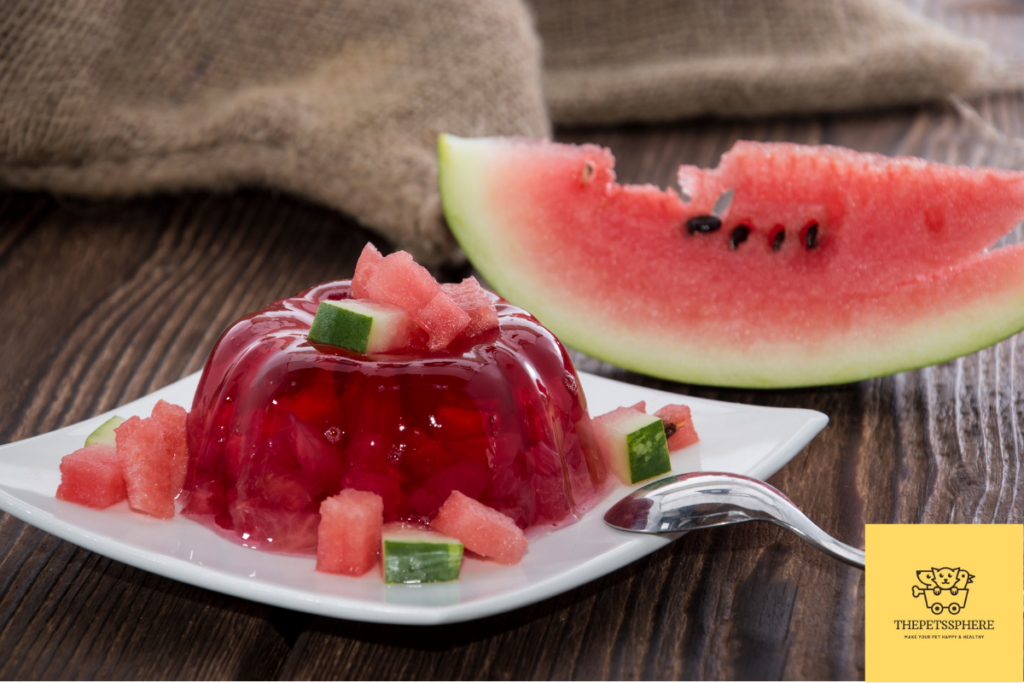Can dogs eat jello? It can be tough to decipher what is and isn’t safe for our canine companions.
Feeding your dog jello is not very healthy for them and may be dangerous, so you should avoid it. Jello can cause gastrointestinal issues in dogs because of the high sugar content or even lead to more serious medical conditions like diabetes. Your pet doesn’t need a sugary treat anyway – they love their food! If you really want to give them something special on occasion, try giving them one of these healthier treats instead.
So, in this article, we will discuss can dogs eat jello, the benefits and risks of feeding it to your dog, and answer some of the questions that people commonly have about this topic.

What is jello?
Jello is a sweet and tangy dessert, but what ingredients are in jello? Let’s take a look.
Jello contains water, sugar, food coloring, and flavoring. Sugar is the main ingredient followed by food coloring which can be either natural or artificial depending on your preference. The last ingredient usually consists of citric acid (or lemon juice), salt, gelatin powder, and sodium citrate for different variations of flavors such as lime or cherry.
Most people know that jello is not really healthy because it has lots of calories from the sugar content but there are some ways to enjoy this treat without consuming too many calories! One way would be to eat smaller portions; another might be to substitute milk with skim milk in order to cut down on the fat and calories.
Risks of feeding jello to your dogs
Jello has been a popular dessert for many years, but feeding it to your dog may come with some health risks.
The ASPCA lists five potential health risks of giving jello to dogs: obesity, tooth decay, choking hazard, vitamin deficiency and food allergy. Obesity is the most common risk as jello contains sugar which can lead to weight gain in dogs that are not active enough.
Tooth decay is another concern as the sugar in the gelatin can break down tooth enamel over time while also causing bad breath due to bacteria buildup from all of the sugary treats.
Choking hazard comes into play because jello is so sticky and stringy; eating too much could cause an obstruction in their throat or digestive tract leading to serious injury or death.
Vitamin deficiency can happen when dogs eat too much jello which can lead to a weakened immune system, liver problems, and seizures. Lastly, food allergies can come into play if your dog is allergic to gelatin or other ingredients in the treats such as soy or cornstarch often found in store-bought brands.
If giving jello as a treat is proving too difficult then there are other yummy alternatives for your dog. For instance, you can try low-calorie (less than 100 calories), high protein, and sugar-free foods like boiled chicken breast with a side of rice or cottage cheese!
Health benefits of jello for dogs
Many of us remember jello as the perfect after-school snack to have with a glass of milk. But did you know that many veterinarians recommend it for dogs? Jello is a low-calorie, high water content treat that can help keep your dog hydrated and healthy during the hot summer months. Here are 5 surprising health benefits of jello for dogs.
Dogs can easily digest jello
Dogs naturally need more protein than humans do (25% more), which means they cannot process carbohydrates well. This makes them unable to break down gelatin effectively, so it passes through their system quickly without causing any harm.
Jello is delicious
Dogs love the taste of sweet flavors! Plus, anything tastes better when it’s served in ice cube trays!
Jello removes toxin
It provides an easy way to add more water into their diet which helps flush out toxins from your furry dog’s body.

Can dogs have strawberry jello?
Dogs have a very close relationship with humans and they enjoy spending time with them just like we do- even if that means eating their food!
Strawberry jello is one of the most popular flavors for kids, adults, and everyone in between so it should come as no surprise that some would want to share this flavor with their dog too. There are three reasons why dogs can have strawberry jello.
- Dogs are very much like humans in that they need to eat a balanced diet with protein, carbs, and vitamins for optimal health.
- As we all know, there are many delicious flavors of Jell-O available on the market today; including strawberry flavor!
- Some people might think that it’s not safe for your dog to eat this because he or she may be allergic or intolerant to strawberries. The fact is that some dogs can tolerate eating certain types of fruits (and vegetables) while others cannot due to their inability to produce an enzyme called amylase which breaks down sugar molecules found in these foods.
One thing you have to make sure the strawberry jello should be free from any artificial sweeteners and excessive sugar.
Some artificial sweeteners like Xylitol present in jello is toxic for dogs.
Is orange Jello bad for dogs?
Orange is safe to consume for Dogs.
However, orange jello that is found on the market is loaded with harmful ingredients like artificial sweetener (Xylitol), artificial flavors, excessive sugar etc..
However, it is perfectly fine to make orange jello for your dog at home. You can offer it as an occasional treat!
Homemade orange jello is a great way to give your dog a special treat. The following steps will guide you through the process of making this delicious snack for your pup.
Ingredients
- 2 cups of water
- 3 tablespoons of cornstarch
- 1/2 cup of sugar
- 1 cup of canned mandarin oranges (drain juice before adding).
Cooking instructions
Mix together the two cups of water with the three tablespoons of cornstarch in a saucepan on medium heat. Add in one cup sugar and mix until it dissolves into the water. Let cook for about five minutes or until the mixture has become thick.
Pour four cups of mandarin oranges into a large bowl and then pour over the cooked mixture from step two. Stir to combine and then place in the fridge to cool for about 30 minutes or so before serving.
Tip You can add a variety of different ingredients to your orange jello such as vanilla extract, cinnamon sticks or chili peppers just make sure that you do not add any additional sugar to the mixture.
How much gelatin can I give my dog?
There seems to be conflicting information about how much gelatin you can give your dog, and whether or not it’s good for them.
We even found a study that suggests eating 10 grams of unflavored gelatin per day could have benefits for the aging process of dogs – so there’s at least one expert who has endorsed this idea.
In any event, if you’re going to provide a supplement like gelatin, it should be small and given with food or mixed into a drink on an otherwise empty stomach. Given these considerations, one tablespoon (15 ml) per day is probably fine in most cases. If your dog doesn’t eat what they are provided with their usual ration of food, then something else may be going wrong with their appetite and can’t be solved by adding a supplement.
Can dogs eat beef gelatin?
Many of us have a soft spot for our dogs and want to provide them with the best food possible.
Feeding your pup beef gelatin can be one way to help keep their joints strong and improve their overall health
Feeding beef gelatin to your dog can provide many benefits. Let’s talk about five of the best ones!
- Beef gelatin can help with joint pain in older dogs.
- It helps maintain healthy skin and coat by providing a source of protein, amino acids, minerals, and trace elements that are essential for healthy hair growth.
- It is easy on stomachs because they digest easily compared to other forms of protein like meat or eggs which can cause upset stomachs for some dogs who have sensitive digestive systems due to age or illness.
- For owners who want their pets’ breath to not smell as bad, feeding beef gelatin will decrease bad breath by acting as a deodorizer.
- Beef gelatin can help with healthy teeth and gums because it is rich in calcium which helps prevent tooth decay or bone loss.
Conclusion
If you have a dog, think twice before giving them jello. The sugar content is too high and the food coloring can cause serious illnesses or diseases over time if they consume it in large enough quantities. To avoid this, give your pet real treats like carrots, apple slices or peanut butter instead of processed human foods that are not an appropriate diet for dogs to begin with.
Do dogs eat articles
- Is it okay for dogs to eat shrimp tails
- Is it ok if dogs eat salmon
- Is olive oil ok for dogs to eat
- Will dogs eat pickles
- Is it bad for dogs to eat mango
- Is gingerbread dangerous to dogs
- Can dogs eat soft tortillas
- Is it okay if dogs eat ice cream
- Can dogs safely eat calamari
- Is kiwi dangerous for dogs to eat

